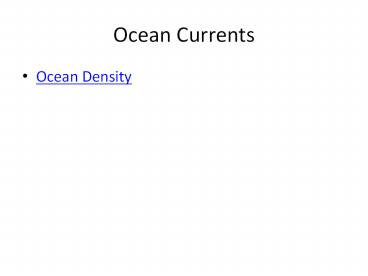Ocean Currents - PowerPoint PPT Presentation
1 / 18
Title:
Ocean Currents
Description:
Ocean Currents Ocean Density Energy in = energy out Half of solar radiation reaches Earth The atmosphere is transparent to shortwave but absorbs longwave radiation ... – PowerPoint PPT presentation
Number of Views:44
Avg rating:3.0/5.0
Title: Ocean Currents
1
Ocean Currents
- Ocean Density
2
Energy in energy out Half of solar
radiation reaches Earth The atmosphere is
transparent to shortwave but absorbs longwave
radiation (greenhouse effect) The atmosphere is
heated from the bottom by longwave radiation and
convection
3
Climatic Variation Seasons on Earth
- Uneven heating of Earths surface causes
predictable latitudinal variation - in climate. Why? - Angle of incidence
equator vs. poles
North Pole
Equator
Earth
South Pole
Thus, radiation is more intense near the equator
compared to the poles. For this reason, its
warmer near the equator than at the poles.
4
Uneven heating of Earths surface causes
atmospheric circulation Greater heating at
equator than poles 1. suns rays hit more
directly 2. less atmosphere to
penetrate Therefore 1. Net gain of energy at
equator 2. Net loss of energy at poles
5
II. What about seasons? Why do we have them?
Earths distance from the sun varies throughout
the year doesnt that cause the seasons?
Tilt! Because of the tilt of Earths axis, the
amount of radiation received by Northern and
Southern Hemispheres varies seasonally
A. Northern Hemisphere has summer when it tilts
toward the sun, winter when it tilts away B.
Southern Hemisphere has summer when it tilts
toward the sun, winter when it tilts away
6
Earths Seasons
- Tilt of the Earths axis towards or away from the
sun creates the seasons
When the north pole tilts toward thesun, it gets
more radiation more warmth during the summer
SUMMER (Northern Hemisphere)
North Pole
Equator
Earth
South Pole
When the north pole tilts toward thesun, the
south pole tilts away So when its summer in the
north, its winter in the south
WINTER (Southern Hemisphere)
7
Earths Seasons
- Tilt of the Earths axis towards or away from the
sun creates the seasons
WINTER (Northern Hemisphere)
When the north pole tilts away from the sun, it
gets less radiation So its colder during the
winter
North Pole
Equator
Earth
South Pole
When the north pole tilts away from thesun, the
south pole tilts toward it When its winter in
the north, its summer in the south
SUMMER (Southern Hemisphere)
8
Air rises and falls in Hadley, Ferrel, and
Polar cells (vertical circulation) Circulation
cells explain global distribution of
rainfall Earths rotation determines wind
direction (horizontal circulation, Coriolis
force)
9
High heat capacity of water and ocean currents
buffer ocean temperatures Land temperatures
fluctuate more, especially in higher
latitudes These differences in surface energy
balance influence air movements, and create
prevailing winds
10
- Salinity The difference in the salinity of hot
and cold water drives the currents. The higher
the salinity of the water, the more dense the
water is. - Density - the state or quality of compactness
closely set or crowded condition. - Water Mass Area of different salinity density
in the ocean.
11
In January
At 30º N S, air descends more strongly over
cold ocean than over land
At 60 º N S, air descends more strongly over
cold land than over ocean
These pressure gradients create geographic
variation in prevailing winds
12
In summer at 60 º N S, air descends over cold
ocean (high pressure) and rises over warm land
(low pressure)
Cool equator-ward flow of air on W coast of
continents Warm poleward flow of air on E coasts
of continents
13
Ocean currents are similar to wind patterns
1. Driven by Coriolis forces 2. Driven by
winds
14
Ocean currents move 40 of excess heat from
equator to poles Driven by circulation of deep
ocean waters Deepwater formation occurs near
Greenland and in Antarctic
60 of heat transport is carried by atmosphere
through storms that move along pressure gradients
15
The Pacific Ocean strongly influences the climate
system because It is the largest ocean
basin Normal ocean current and wind direction in
central Pacific is easterly
16
Winds and surface water
- Wind blowing over the ocean can move it due to
frictional drag. - Waves create necessary roughness for wind to
couple with water. - One rule of thumb holds that wind blowing for
12 hrs at 100 cm per sec will produce a 2 cm per
sec current (about 2 of the wind speed)
17
Top-down drag
- Wind acts only on the surface water layer.
- This layer will also drag the underlying water,
but with less force. - Consequently, there is a diminution of speed
downward. - Direction of movement is also influenced by the
Coriolis Effect and Ekman Spiral
18
Geostrophic Flow
- Surface currents generally mirror average
planetary atmospheric circulation patterns































